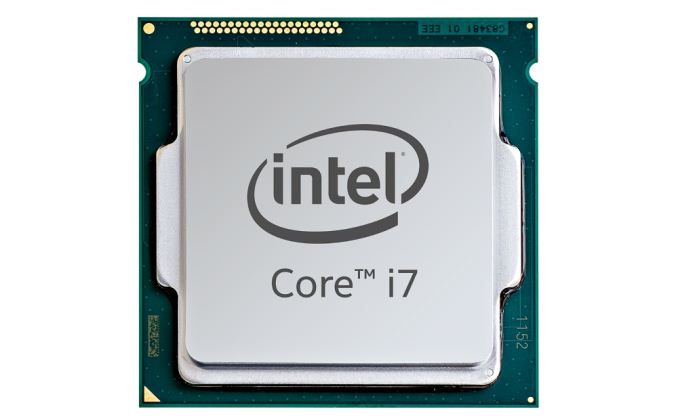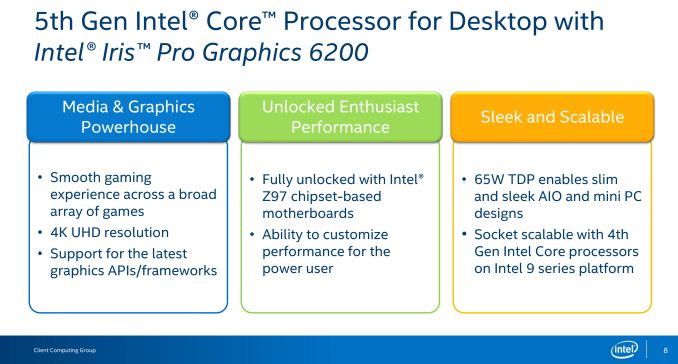The Intel Broadwell Desktop Review: Core i7-5775C and Core i5-5675C Tested (Part 1)
by Ian Cutress on June 2, 2015 7:45 AM ESTBroadwell-DT: Initial Thoughts
The new Broadwell desktop processors are somewhat out of sync with our regular expectations from Intel. Due to issues surrounding the 14nm node, as well as the cost, the whole Broadwell line from tablet to table-top has come out slower and more staggered than any Intel release in recent memory. As a result, the initial launch from Intel today is a pair of 65W desktop socketed models backed up with three 65W soldered down models whose true heritage is a chip primarily designed for large laptops and all-in-one devices.
Normally we would expect a range of desktop models from 35W up to 88W or higher, but socketed Broadwell-DT today only exhibits two units at 65W. This immediately puts a slight damper on those expecting to upgrade from Haswell’s high-end, or those wanting to go from something like a Pentium G3258 on Haswell to Broadwell’s top SKU. As a result, we have to keep our expectations in check – 65W should on paper perform nearly as well as an 88W part would, except it would be reduced by several hundred MHz. Meanwhile as these processors are also fully-unlocked and overclockable, we're left to ponder whether or not the stock frequencies actually matter in that case.
Due to the differential tangent at play, these processors also exhibit Intel’s best integrated graphics package, Iris Pro (GT3e), previously reserved only for soldered down/laptop/mini-PC orientations. This graphics package comes with largest number of execution units available from Intel, 48, alongside 128MB of eDRAM that acts almost like an L4 cache. This helps alleviate memory bandwidth pressure by providing a large(ish) pool near the CPU but with lower latency and much greater bandwidth than main memory. The eDRAM has the greatest effect in graphics, but we also saw some moderate increases in our non-3D regular benchmark suite.
The benefit of the graphics package, Iris Pro 6200, means that Broadwell-DT takes the crown as the fastest socketed graphics available. Our testing showed that the even the second-tier socketed SKU, the i5-5675C, outgunned the previous title holder, AMD’s A10-7870K. Despite having the i7-5775C in to test, due to time and firmware issues, we were unable to run the numbers on the integrated graphics but will do so in a later piece.
The key element to Broadwell-DT is not to consider it a natural successor to Haswell. It doesn't so much replace Haswell-K at this time, so much as it occupies a space Intel has left neglected since the launch of Haswell – the ultimate Intel integrated graphics solution. For users on integrated graphics, where money is no object, Intel now offers you the option to combine the regular CPU performance associated with Intel and a GPU that has the added performance benefits of on-chip, high-bandwidth eDRAM. The only question is whether that combined performance is worth the potential cost, and some would say no, pointing at a combined APU + GPU solution for equivalent or better gaming performance for the same price.
Pricing for the i5-5675C is listed as $276, slightly higher than the price of the i5-4690K which is at $236 on Amazon (reduced from $265). The i7-5775C is a bit higher at $366, also a margin higher than the i7-4790K which is $339 (reduced from $380). This makes Broadwell a tough sell right now in most circumstances unless you are absolutely limited to integrated graphics and want the best solution possible in a configurable PC. Given that Intel has also mentioned Skylake in their recent Computex keynote, it implements an abnormal situation that Intel has never been in with a new platform being talked about in the same breath. We have been told that these parts exist because users wanted them, and it has been interesting to see just how the added eDRAM changes the performance with discrete graphics in the mix.












196 Comments
View All Comments
MrSpadge - Tuesday, June 2, 2015 - link
Simply use something representative of the current situation. Not old numbers which may be totally meaningless today. In Europe we have simple price comparison engines like geizhals.eu where it's really easy to find typical prices. Just exclude obvious outliers and cheap products not yet deliverable and voila, you've got the current street price.nathanddrews - Tuesday, June 2, 2015 - link
In Europe? You mean on the Internet? LOLThere are tons of price comparison websites, but why should AT take the time and be responsible for tracking down pricing when we can all do that in our own areas or from our favorite retailers? They don't know where I like to shop or what currency I use, so it seems like a waste of their time. I'd much rather get quality performance analyses on a more regular basis than have them worry about updating price indexes. Who knows? Maybe their new parent company can do that for them off to the side or something?
MrSpadge - Wednesday, June 3, 2015 - link
I never see people from the US referring to them. They seem to just use Newegg or Amazon. And getting prices for European shops won't do AT any good, as they're mainly writing for the US.And AT has to look up the launch prices of the hardware anyway when they write a review. How much more time would it take to instead look up the current price in a comparison engine? Again, I'm not talking about updating prices dynamically.
I they're not doing this you always get comments like "who in their right mind would buy x? Vendor y must be totally stupid to keep offering this". Simply because the launch price is far higher than the current price.
Senpuu - Wednesday, June 3, 2015 - link
Why should AT take the time, you asked? Well, why should they list a price at all then? Hell, why provide any information to the reader beyond specs and performance metrics? Why even talk about the market at all? There is obviously value to be had in doing so and it comes down to where you draw the line. Whereas you would rather they not 'waste their time', I would rather not waste mine by having to question whether a product is being valued near current market price or some esoteric launch price, and then being forced to google multiple things myself to get a feel for 'real world' prices. No, the price they come to will likely not tell me the exact total of the item in question at whatever preferred retailer a reader happens to use, but it will probably be within 5-10% of that value, which is highly useful for at-a-glance comparisons and understanding where something sits in a market segment.We're not talking about a large amount of effort here, but I'd rather AT do it than myself; it's less effort for them and it benefits a large portion of their readers. Simply provide a disclaimer about the methods used to gather the data as well as a liability warning, and everyone's happy.
Thud2 - Saturday, June 13, 2015 - link
Very good point.yannigr2 - Wednesday, June 3, 2015 - link
There are official price cuts and so you have new OFFICIAL pricing that it is fair to put in the charts. If the launch price of 7850K was $500 and the last official price was $100, wouldn't be the above charts completely misleading? People do have a price/performance ratio in their minds when looking at these charts. In fact for 90% that's the biggest parameter when looking at those charts. And those charts LIE exactly there.manifestation88method - Sunday, September 27, 2020 - link
Nice post https://discoversoulpath.com/yannigr2 - Wednesday, June 3, 2015 - link
You can always take the last OFFICIAL price, but nevermind. It's AMD's pricing that it is wrong anyway. Who cares about poor poor AMD?Gothmoth - Tuesday, June 2, 2015 - link
intel is sitting on it´s laurels because there is no competition.AMD is no competition for poweruser.
users want broadwell..mhm.. aha....
i am the only one who wants intel to make a fast 6 (or better 8) core system without integrated graphics, that runs not to hot and does not cost a fortune?
can´t we have such a CPU for 500-600 euro?
ok then i stick to my OC ivy bridge for a few more years.. and you intel can complain about declining sales.
MrSpadge - Tuesday, June 2, 2015 - link
That's exactly what i7-5820K is for. If it consumes too much power for your taste - well, that's simply the price you have to pay for more cores.